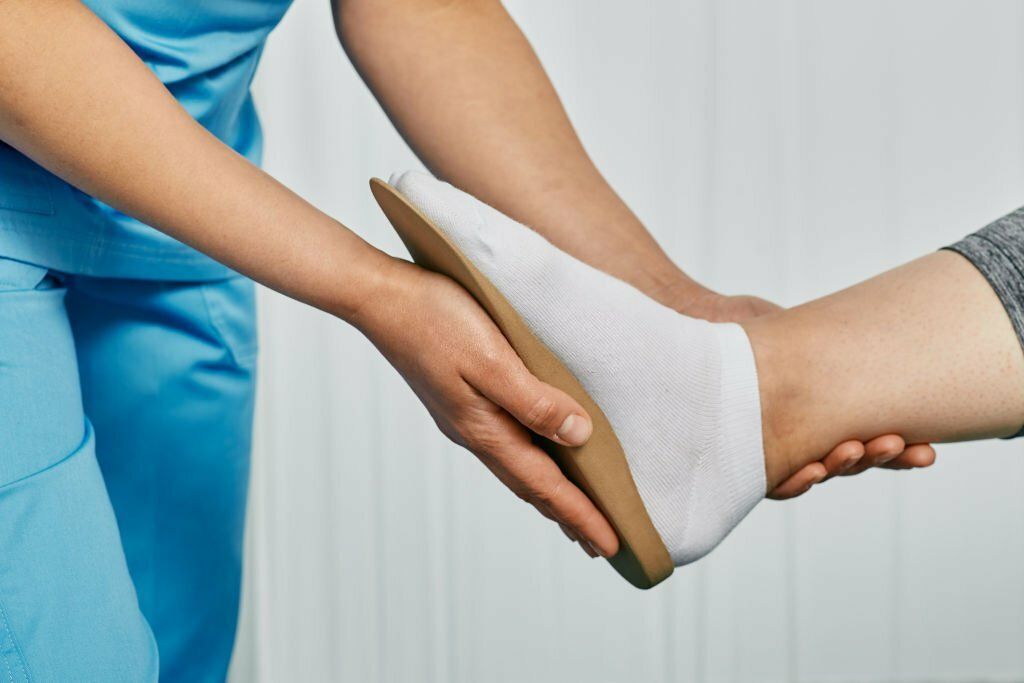Foot Pain
What is Foot Pain?
Foot pain is something many of us experience at some point in our lives, and it can take different forms. This discomfort often happens when there is stress on the different parts of our feet, like the bones, muscles, tendons, ligaments, and joints. It is essential to understand what causes foot pain to manage it effectively and prevent it from coming back.
Common Causes of Foot Pain:
- Improper Footwear: Wearing shoes that do not fit well or provide enough support can lead to foot pain. It is crucial to choose footwear that suits your feet and the activities you engage in.
- Overuse or Strain: Doing too much, too soon, especially in activities like running or walking long distances, can strain the feet and cause pain. Gradual increases in activity can help prevent this.
- Injuries or Trauma: Accidents or injuries, like stubbing your toe or dropping something on your foot, can cause immediate pain. Quick attention to such injuries is important for proper healing.
- Medical Conditions: Conditions like arthritis or diabetes can contribute to foot pain. Managing these conditions well can help alleviate foot discomfort.
- Structural Issues: The way your feet are structured, such as having flat feet or high arches, can contribute to foot pain. Understanding your foot's structure helps in finding appropriate solutions.
Foot Pains Risks
Recognising the potential risks associated with foot pain is essential for proactive care. Untreated foot pain can lead to various complications, affecting mobility and overall well-being.
Risks of Ignoring Foot Pain:
- Development of chronic conditions
- Altered gait and posture
- Reduced quality of life
- Impact on daily activities
Common Foot Pain Symptoms
Understanding the symptoms of foot pain is crucial because it helps you take the right steps to address it on time. Different types of foot pain can show different signs, and being aware of these indicators is the first step in seeking the help you need.
- Sharp or Dull Pain: Foot pain can feel sharp, like a sudden jab, or dull, like a persistent ache. Pay attention to the type of pain and where it is located to help pinpoint the cause.
- Swelling or Inflammation: Swelling, where your foot becomes larger than usual, and inflammation, which can make it red or warm to the touch, are common signs of foot pain. These can be indicators of various issues, from injuries to medical conditions.
- Tingling or Numbness: If you experience a tingling sensation or numbness in your feet, it could be a sign of nerve-related foot pain. This is especially important to address as it may affect your balance and coordination.
- Changes in Skin Color or Temperature: Notice any changes in the color of your skin on the feet or if they feel unusually hot or cold? These changes can be clues to underlying problems causing foot pain.
- Difficulty Bearing Weight: If you find it hard to put weight on your foot or experience pain when standing or walking, it is a clear indication of foot discomfort. This may be due to various reasons, such as injuries or structural issues.
Treatments and Preventions
When it comes to foot pain, finding relief and preventing, it from returning involves a thorough strategy that combines treatments and preventive measures.
Treatment Options:
- Customised Orthotics: Customised orthotics are specially designed shoe inserts that provide support and alignment for your feet. They can help address specific foot issues and distribute pressure more evenly.
- Physical Therapy: Physical therapy involves exercises and stretches tailored to your individual needs. It aims to strengthen your feet and improve flexibility, promoting overall foot health.
- Medications for Pain Relief: In some cases, medications may be recommended to alleviate pain and reduce inflammation. These can include over-the-counter pain relievers or prescription medications prescribed by your podiatrist.
- Rest and Elevation: Allowing your feet time to rest is crucial for recovery. Elevation, propping your feet up, can help reduce swelling and promote healing, especially after a day of activity.
- Surgical Interventions (if Necessary): In more severe cases or when conservative measures aren't sufficient, surgical interventions may be considered. Your podiatrist will discuss this option if it's the best course of action for your specific situation.
Preventive Measures:
- Proper Footwear Selection: Wearing the right shoes is fundamental to foot health. Choose footwear that provides proper support, fits well, and is suitable for the activities you engage in regularly.
- Regular Foot Exercises: Simple exercises, like toe curls and ankle rotations, can strengthen the muscles in your feet. Your podiatrist can recommend exercises tailored to your needs.
- Maintaining a Healthy Weight: Carrying excess weight puts added stress on your feet. Maintaining a healthy weight through proper diet and exercise can reduce the risk of foot pain.
- Routine Foot Care Practices: Practicing good foot hygiene, such as keeping your feet clean and dry, trimming your toenails properly, and moisturising, can prevent issues like infections and ingrown toenails.
- Regular Check-ups with a Podiatrist: Scheduling regular check-ups with a podiatrist is essential for proactive foot care. They can identify potential issues early on and provide guidance on maintaining optimal foot health.
Schedule Your Appointment with a Podiatrist
Taking charge of your foot health starts with consulting a qualified podiatrist. Schedule an appointment to assess your foot pain, receive a personalised diagnosis, and develop an effective treatment plan tailored to your needs.
Our experienced team at Port Stephens Foot Clinic is dedicated to providing top-notch podiatry services across multiple locations in Newcastle, the Hunter Valley, and Port Stephens. Contact us today to prioritise the health and well-being of your feet.
Foot problems
How to fix Foot problems
Cutting Toenails
Cutting Toenails Newcastle Podiatry
Diabetes
We treat diabetic podiatry with a range of services and assessments
Heel Pain
Newcastle Heel Pain Podiatry
Ingrown Toenails
Ingrown Toenails Newcastle Podiatry
Plantar Fasciitis
Plantar Fasciitis Newcastle Podiatry
Custom Orthoses
Custom Orthoses Newcastle Podiatry
Corns and Callus
Corns and Callus Newcastle Podiatry
Bunions
Bunions Newcastle Podiatry
Children’s Feet
Children’s Feet Newcastle Podiatry
Fungal Nails
Fungal Nails Newcastle Podiatry
Heel Pain in Children (Calcaneal Apophysitis)
Heel Pain in Children (Sever's Disease) Newcastle Podiatry
Achilles Tendonitis
Achilles Tendonitis Newcastle Podiatry
Plantar Warts
Plantar Warts Newcastle Podiatry
Sesamoids
Sesamoids Newcastle Podiatry
Foot Pain
Read MoreCorn & Callus Removal
Read More- Port Stephens Foot Clinic Lemon Tree Passage Location 1061 Lemon Tree Passage Rd, Tanilba Bay NSW 2319, Australia
- Port Stephens Foot Clinic Medowie Location 28A Ferodale Rd, Medowie NSW 2318, Australia
- 1/199 Adelaide Street Raymond Terrace 2324 Raymond Terrace, 1/199 Adelaide St, 2324, NSW, Australia
- Port Stephens Foot Clinic Lambton Location 94 Elder St, Lambton, NSW, Australia
- Port Stephens Foot Clinic Kurri Kurri 110B Lang St, Kurri Kurri, 2327, NSW, Australia
© Copyright 2025 | All Rights Reserved | Port Stephens Foot Clinic





















